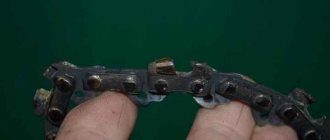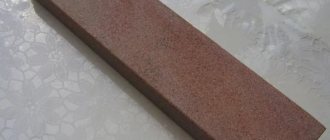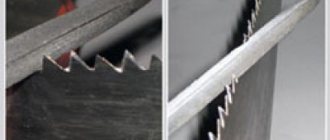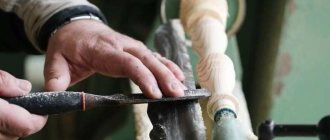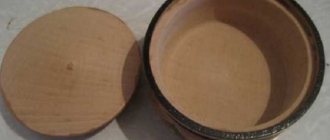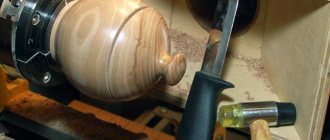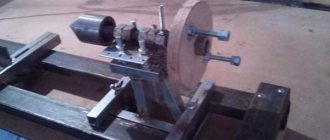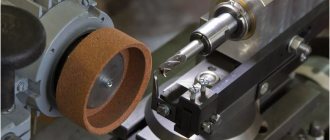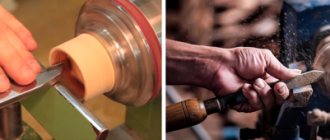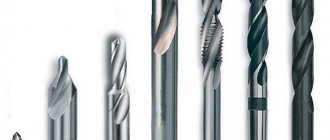- Application of tapes
- Typology of paintings
- Saw maintenance
- Features of breeding tape webs
- How to properly sharpen a blade? Method 1: Full profile sharpening
- Method 2: Sharpening the tooth edges
A properly sharpened band saw for metal and wood is the key to productivity and long service life of the tooling. As a rule, such services are provided by special organizations, but if you know the sequence of actions and features of the process, you can sharpen a saw that has become dull on your own.
Design features of band saws
- Band devices intended for cutting wood are made from alloy tool steel, which has a hardness of 40 to 46 HRC.
Elements of a tooth.
- The width of the cut (kerf) of band tools is much smaller than that of disk analogues. When cutting cheap wood, this point is not so noticeable, but when cutting valuable and exotic types of wood, it is critically important.
- The machine can cut workpieces of any size. At the same time, the band tool works quickly and creates a high-quality cut.
- There is very little waste (shavings, sawdust) when using this type of saw.
Note! In order for the machine to always work stably and efficiently, its maintenance should be approached with the utmost responsibility. Sharpening and setting of band saws for wood must be carried out in a timely and competent manner.
Profile, teeth and sharpening angle
International classification of tooth profiles.
Tape devices have different tooth geometries, which depend on the type and characteristics of the materials being cut. Wood tools can be carpentry or dividing. There is a third type, designed for sawing timber and logs. All these subspecies have their own parameters and shape of the teeth.
The sharpening angle of wood band saws is selected by the manufacturing company based on several points. The main one is that the harder the material, the smaller the rake angle should be. Below is a table with the main parameters of the saws.
Saw characteristics | Carpentry fixtures (1 profile) | Dividing analogues | For cutting logs and beams (4 profile) | ||
| 2 profile | 3 profile | ||||
| Thickness of the canvas, mm | 0.6-0.9 | 0.9-1.2 | 0.9-1.2 | 1.4-2.2 | |
| Width of the canvas, mm | 10-60 | 50-175 | 50-175 | 230-350 | |
| Teeth pitch, mm | 6-12 | 30-50 | 30-50 | 50-80 | |
| Height of teeth, mm | 2-6.5 | 9-13 | 7.5-15 | 16-24 | |
| Rounding radius at the cavity, in mm | 1.5-2.5 | 3-4 | 3-4 | 5-8 | |
| Rear angle, in degrees. | 35 | 20 | 15 | 12 | |
| Sharpening angle, in degrees. | 50 | 45 | 45 | 53 | |
| Front angle, in degrees. | 5 | 25 | 30 | 25 | |
This is interesting: How to make a spot welder from a regular microwave
Manufacturing process
To manufacture the power parts of the machine, it is necessary to use sheet metal 10 mm thick. To draw the outlines of such parts for their further cutting, you can use the drawing as a guide. It is not necessary to adhere to exact dimensions, since only the dimensions of those parts that you are going to process on a belt sander will depend on them. You can draw the outlines of the parts on a sheet of metal with a marker and use a grinder and jigsaw to cut them out. It is much easier to cut such parts with a plasma cutter, but not everyone has such equipment at home.
Base, body parts and engine before assembly
To make the base of a homemade grinder more reliable, it is best to use a sheet of metal 12 mm thick for its manufacture. You can use screw connections to assemble the base of the angle grinder, but then you will have to drill a lot of holes, which will greatly weaken the entire structure. Assembling the base of your machine using electric welding will be much easier and more reliable.
Machine base
The semi-circular grooves on the belt sander parts, rotating the platform on which the rollers are located, will take a long time. To make such grooves yourself, you will have to tinker with a drill, cutters and files, and also use a drill. You can make your task much easier if you have a qualified milling machine make these grooves.
Plastic model of the machine: thanks to the rotating group, the angle grinder can be in a vertical position.
It is best to use titanium or duralumin (D16) to make the rollers of your homemade mini-machine. If it is impossible to find gaps from these materials, then steel can also be used, but the rollers must be made as light as possible by choosing metal from their interior. To make the rollers of a homemade machine, you will need the help of a qualified turner, just take care to prepare a drawing for it.
Sharpening machine rollers
The roller of a larger belt grinder, which will be mounted on the electric motor shaft, will still have to be made of steel, since a titanium rod of this diameter is very difficult to find, and duralumin may not withstand significant loads. For the entire homemade machine, you will need to make 4 rollers, the dimensions (diameter) of which are as follows: one drive roller - 150 mm, one tension roller - 100 mm, two small ones - 70 mm. If you plan to make a mini machine, the diameters of the rollers may be smaller.
When assembling a homemade machine with ready-made rollers, it is very important that they lie strictly in one row. Otherwise, you will constantly experience the tape slipping. The width of the rollers depends on the size of sanding belt you will use on your equipment. When making a drawing for the manufacture of rolls, be sure to take into account that they must have a barrel shape, this will ensure reliable retention of the sanding belt on them during operation. To give the rollers this shape, a small chamfer is made from each edge: 1–2 mm.
The finished rolls of your homemade belt sander should have a smooth surface, this must be reported to the turner who will make them. The bearings on which they will rotate must only be of the closed type, otherwise they will quickly become clogged with dust generated during operation of the grinding machine. In order for your homemade equipment to work for a long time and without interruptions, you need to choose bearings that have a class of at least 6a. The rollers of the grinding machine rotate at a high frequency, so the bearings for them must be of the highest quality.
Grinder ready in horizontal position with additional table
Preparing the device for work
With constant use of the tool, a decrease in the quality of the cutting edge is inevitable. It becomes dull, and the width of the teeth is reduced. Based on this, sharpening a wood saw and setting it up are necessary components of the maintenance of a band saw machine.
It should be noted that the setting of the teeth should be carried out before sharpening them, and not vice versa.
Tool layout
Application of an adjustable machine.
Setting is the process of bending the teeth to the sides. This operation is necessary to ensure that the saw blade does not clamp in the workpiece, and also to reduce friction during operation.
There are 3 main types of breeding.
- With the classical method, the cloves are bent left and right in strict order.
- With the stripping method, every third of the teeth remains in its original position. It is optimal for devices designed for cutting particularly hard wood.
- With a wavy setting, each tooth is given its own separate bend value. In this case, the profile of the canvas takes on the appearance of a wave. This method is the most complicated.
Note! When setting, you should not bend the entire clove, but only a third or two-thirds of it from the top. Manufacturing companies advise performing the operation so that the bending range is within 0.3-0.7 millimeters. The work is carried out using a specialized spreading tool.
Sharpening the saw
Elbor circles having different shapes.
Before sharpening a saw blade for wood or a band tool, keep in mind that more than 80% of incidents with damage to devices (including their rupture) occur due to non-compliance with work standards.
- The need for surgery is determined visually. In this case, you should pay attention to the condition of the teeth and the quality of the cut walls (for example, their increased roughness).
- The circles for the point of the band tool are selected based on the degree of hardness of the teeth. To work with tools made of tool steel, corundum discs are required. Bimetallic saws are sharpened on borazone or diamond wheels.
- The shape of the emery for belt devices must be selected based on their parameters. Cup, profile, plate, and flat circles are known.
- Before carrying out the operation, it is necessary to turn the saw out and let it hang in this position for about 10-12 hours.
Manual tool maintenance.
The wood saw sharpening scheme should take into account the following provisions.
- Metal removal along the profile of the teeth should be uniform.
- Excessive pressure from the sharpening device must be prevented. It can lead to annealing.
- The profile of the blade and the height of the teeth must remain unchanged.
- Liquid cooling must be provided during the operation.
- There should be no burrs on the teeth.
Pay attention! The theoretical instructions for sharpening band saws on wood indicate that it should be done either on the front side of the teeth, or on both the back and the front. In real life, most specialists and amateur craftsmen perform the operation only on the back side, because it's more convenient.
Sharpening methods
The photo shows automatic full-profile sharpening.
You can prepare a tool for work using special sharpening devices (for example, machines with wheels of different materials and shapes) or manually. Before you properly sharpen a wood saw, you should learn the basic methods for carrying out this operation.
The first method is full-profile sharpening.
- It is of the highest quality, the operation is carried out on an automatic machine.
- Elbor emery, chosen exactly in shape, passes the entire surface of the interdental cavity along with the accompanying planes of adjacent teeth in one movement.
- The creation of angularities at the tips of the teeth is completely eliminated.
- A relative disadvantage of such sharpening is the need to have at your disposal the appropriate number of wheels for blades with different profiles.
A tool sharpened along the edges.
The second method is to sharpen the edges of the teeth.
This can be done either manually or using a professional machine.
- Having chosen a machine, you need to decide on the wheel to be used. As a rule, it is flat. Specialized sharpening devices should only be used when there is a lot of work to be done.
- In domestic conditions, sharpening is best done with your own hands - using regular mechanical sandpaper or using an engraver. When performing the operation, do not forget about personal protection and use gloves, a mask or special glasses.
Working with an engraver.
- When you and your neighbors don’t have an engraver, machine, or emery, you can sharpen a band saw using the traditional folk method - using a needle file.
DIY grinder: drawings with dimensions + assembly instructions
During development, special attention is paid to the configuration of the rollers, the method of fastening the product and the optimal power of the power unit. Read more about this.
Making rollers
Particular attention should be paid to the manufacture of the main drive roller, which acts as a pulley! It should be quite massive. This will avoid unnecessary jerking during the starting torque due to the presence of inertia at rest. The speed gradually reaches the desired values. If we take into account the use of a standard motor in the drive design, with a slip of no more than 9%, at a rated speed of 1500 rpm, the speed will not exceed 1400 rpm maximum.
Steel or cast iron are not suitable for making the main part because the motor will be stressed when starting up or will not be able to turn the overly heavy workpiece at all.
There are two options to solve this problem:
- Manufacturing a hollow steel roller to reduce weight according to the principle: larger diameter - deeper cavity. The exact dimensions can be calculated from a reference book, but special accuracy is not required.
- Second option: make a duralumin roller of grade D16 and higher.
It is recommended to make an end groove on the pulley, the dimensions of which will be identical to the dimensions of the belt intended for use. This will help prevent uncontrolled belt slippage if the rollers are not positioned correctly in the plane of rotation.
It is recommended to do the same with the remaining rollers, including the tensioner. The use of duralumin for their manufacture will eliminate the work of grinding cavities to regulate weight.
The degree of roughness of the roller surface is of no small importance. Recommended limit values: Ra1.25-Ra2.5. Increased roughness will lead to premature wear of the belt base, and roughness below the specified limit will contribute to unnecessary slippage during long-term operation.
The rollers must be installed using sealed bearing sets based on self-aligning bearings with a fixed outer ring. With this installation, abrasive or other particles cannot get on the roller shaft. When choosing bearings, it is necessary to take into account the correspondence of their bearing parameters to the maximum speed of the power unit.
The rollers can be secured with regular cotter pins or with a shoulder on one end of the shaft, as required by the standard. The drive shaft must have a keyway in common with the drive shaft.
Motor and turntable
When planning to assemble a belt grinding machine with your own hands, you should pay special attention to the choice of unit. The most commonly used engine is 0.75 kW (although up to 1.5 kW is not prohibited) with a rotation speed of 1500 to 3000.
Please note that the belt may not be able to withstand high speeds. As a rule, engine power is selected based on planned operations on the assembled machine. If rough work predominates, with a high load on the drive, a more powerful control unit is installed, but with a lower number of revolutions, and if only surface grinding is required, the parameters remain within the above limits.
The grinding process is characterized by significant contamination in the form of microscopic dust particles, so the motor must be of a closed type with its own fan. It is better to ignore the recommendations of “experts” on using a motor from a used washing machine.
To design a homemade grinder, you will need dimensional drawings; in addition, it is good to think about safety and ease of use on the assembled device. It requires:
- Rotating table.
- Pressure plate on the back of the belt for support.
To accomplish the first task, the stage bracket must be movable, capable of being rotated 90 degrees and fixed at the extreme points. Recommended table thickness: at least 15 mm, preferably duralumin.
The machine frame, sanded near the bearing surface, is suitable for the bearing surface.
Do-it-yourself grinder from an angle grinder: drawings
Drawing of an angle grinder with dimensions for self-assembly
This is one of the simplest DIY grinders. The design of such a mechanism is primarily intended for cleaning weld seams. However, if it is firmly fixed to the table, it can be successfully used as a sharpener for sharpening cutting tools or knives, axes, etc.
Grinder for drill
A drill-grinder is a special accessory that can be made in several stages. There are hundreds of options for what this could be. We chose a non-standard model.
To work, you will need a shaft with gears, bearings and sheet metal.
| We cut out two plates measuring 110 × 250 mm. | |
| We drill the necessary holes on each of the plates. | |
| This part will supply bearings for adjustment. | |
| Then take the "stud" and cut it to 120mm. | |
| We install homemade rollers on the studs and fasten them with bolts. | |
| Pull the tape and secure it on the other side. | |
| We make the basis for attaching the grinder. | |
| We attach the grinder to the frame and fix the drill with clamps. | |
| Don't forget to cut a corner for easy attachment of the knife when sharpening. |
These grinders can help sharpen knives or flat parts.
Application of tapes
The key component of every band saw is the band saw (blade). Band saws are widely used when working with wood, metal, rubber, plastic and various flexible materials.
There are three types of these products.
- Manual tape devices - these machines can be called household ones; they are most often used at home.
- Desktop modifications - these units are often purchased for small industrial facilities, woodworking companies, and workshops.
- Stationary units - such installations are classified as professional; they are used in large industries, factories, factories, large workshops, and so on.
Typology of paintings
The basis for the division of saws of this type is the material of manufacture and the elements being processed. In accordance with such aspects, the following types of canvases can be distinguished.
- Wood saws. The key materials for their manufacture are carbon and alloy steels; their hardness reaches 40–45 HRC. All teeth are subject to mandatory hardening with high-frequency currents. It should be noted that this blade material can be used for cutting thin non-ferrous metals or carbon steels.
- Canvases for metal. Such tools are made from high-speed or spring steel (cobalt and tungsten are added to the structure). These saws already carry a strength of up to 69 HRC. To obtain high hardness and broad capabilities, stellite or other types of durable alloys can be welded onto the teeth.
Teeth and sharpening angles
Band saws have different tooth geometries due to the different types and properties of the material being processed.
If we consider wood, then the teeth are divided into:
- - carpentry;
- - divisive;
- - for sawing logs.
As for sharpening angles, the manufacturer determines this parameter. Basically, it is accepted that the harder the material, the smaller the rake angle.
For metal band saws, the teeth are usually shaped either standard or with a positive rake angle. Let me clarify this point a little: the standard tooth shape is used for sawing thin-walled material, and the shape with a positive rake angle, as you might guess, is used for cutting thick-walled material.
I suggest looking at a small picture that can explain what profiles a tooth can have and where they, these same profiles, are applicable.
In addition, the pitch of the teeth is important. So, for example, for a thin-walled material you should use a tool with a small number of teeth, and for thick-walled material, on the contrary, with a large number of teeth per inch.
Now let's take a look at the picture, in which we can clearly see how saws with variable tooth pitch differ from saws with a constant tooth pitch.
Often, saws are made with variable pitch in order to eliminate the resonance effect.
Next, I propose to find out what types of band saw layouts there are.
This is interesting: Characteristics and passport of the 2M112 desktop drilling machine
Characteristics
Sharpening a band saw has a number of the following features:
- It is prohibited to use abrasive discs and hand-held sharpening tools with uneven wear on the working surface;
- when turning, it is important to perform all movements evenly, without jerking or uneven movement of the tool, since there is a high probability of violating the geometry of the teeth;
- the machines used must have liquid cooling to prevent overheating of the equipment and tape;
- after completion of the work, there should be no burrs or chips on the surface, as they can negatively affect the quality of cutting;
- when sharpening a tool for winter use, it is important to increase the angle of inclination of the teeth to 900, however, it is unacceptable to use such a tape for woodworking in the summer due to increased loads on the cutting edge;
- when sharpening on machines, you need to make sure that the disk is positioned correctly relative to the belt profile;
- the speed of the grinding disc is selected so that the metal is not heated red hot, since in this case it will lose its strength properties;
- if the band saw has been operated without maintenance or the recommended service life has been exceeded, then when turning you will need to remove a larger layer of metal in one pass;
- to control the quality of tool sharpening, it is recommended to use a new tape as a standard;
- It is prohibited to change the factory shape of the teeth, as the saw will become unsuitable for use;
- the need for sharpening is determined by the degree of wear of the teeth by 35% of the original dimensions.
Saw maintenance
To maintain the blades, it is not enough to sharpen the teeth; they also need to be set apart. These two procedures are performed in order of succession: they begin with setting the teeth, and end with sharpening them. This chronology of work must be strictly observed. Dilution is carried out in order to reduce saw friction in the process of cutting a particular material (wood, metal, plastic, etc.). There are several methods of breeding, which depend on what elements need to be obtained after processing and the strength of the starting piece.
Setting up band saw equipment
Correct and high-quality work of carpentry installation directly depends on the settings of the equipment. There is an installation and configuration diagram. First, the wheels are parallel to each other. Next, fluoroplastic washers are installed, which are necessary to prevent vertical displacement.
For the first time, the launch is carried out without guides. At this stage, the smooth start-up and cleanliness of the engine are checked, then a test cut is made with a knife, but with minimal loads. To work with a larger load, a block with guide belts is used. This design consists of two halves that are installed along the line of the cutting blade.
Previously, craftsmen made not only machines, but also cutting blades with their own hands. It is difficult to close a tape assembly into a ring on your own, and this requires at least some initial experience in assembling the machine. Sharpening according to the model is also done manually. You can do all this yourself, saving money, but the modern market is simply filled with all sorts of devices and parts that improve the quality of material processing or make the equipment multifunctional. The main thing in this matter is to remember about safety precautions, because serial or home-made models pose a great danger to human health.
Sharpening methods
Sharpening a band saw for wood can be done in one of the following ways:
- full profile;
- only edges.
Full profile turning has the following advantages:
- operations are carried out with high precision, as they are performed on automated machines;
- specially shaped emery passes the entire surface of the space between the teeth simultaneously with the planes of adjacent cutting edges in one movement;
- tops of regular shape without angularity are formed.
Sharpening of edges can be done in the following ways:
- A machine with a flat abrasive wheel or a special shape is selected, depending on the profile of the cutting edges.
- At home, it is recommended to carry out processing with an engraver or regular sandpaper of suitable sizes. To operate, you will need to wear goggles and gloves.
- In the absence of tools from points 1 and 2, the use of needle files is allowed.
There are two main ways to sharpen a band saw.
1 way
Referred to as full-profile sharpening. It is produced on an automatic machine, which immediately means that the sharpening will be of high quality. The principle of sharpening is based on passing the entire interdental cavity with the corresponding surfaces of adjacent teeth in one movement with a CBN wheel, which is directly selected according to the shape. It follows from this that we will not get angular shapes at the base of the teeth. This is simply out of the question.
Wheels are often used, the abrasive of which can be electrocorundum, CBN or diamond sputtering.
Perhaps the only significant disadvantage of this method is that different saws require different circles.
Method 2
Characterized by sharpening of the tooth edges. It can be done using a machine, then the circle is selected again. Manual processing is carried out by an engraver or on a conventional machine in compliance with safety precautions, or using a needle file (its essence is to make several movements along the front or back surface of the teeth)
To sharpen a band saw with your own hands, you need to:
- — eliminate strong pressure on the circle;
- — ensure uniform metal removal along the tooth profile;
- — ensure the preservation of the height, as well as the profile of the tooth;
- — control the absence of burrs;
- — use coolant.
If there are nicks on the surface of the tooth, the saw will quickly become dull. Therefore, it is important to have a smooth tooth surface. It is also necessary that the radius at the base of the tooth is maintained. This is necessary to prevent cracks and tearing of the fabric.
The saw should be sharpened as soon as there is noticeable force to move it in the wood. Most woodworkers are happy to sharpen their tools, but may call a professional if the teeth need to be set. The alignment should be done after 4-5 sharpenings or if the saw “moves away” from the intended direction due to incorrect alignment. Electrically hardened teeth cannot be sharpened by hand, and dull replacement blades for fine work are simply thrown away.
Homemade grinder - making a belt grinder with your own hands
A grinding machine is a belt sanding machine used for dry grinding of metal products, various alloys, wood, artificial stone, plastic and other materials.
Homemade assembly of an angle grinder
The question of how to make a belt grinding machine with your own hands is asked by many home craftsmen, because with the help of such equipment you can perform various technological operations with products made from various materials. Using a belt grinding machine, you can remove burrs, eliminate surface defects, clean rust, remove scale, eliminate the effects of plasma and laser cutting, and clean welds.
Making your own grinder
It would seem that buying branded equipment and using it in your workshop for more than a year is much easier than making it yourself. However, not everyone can afford to pay a decent amount for a production car from a well-known manufacturer. In addition, it is not difficult to make such a machine yourself, which will have the necessary functionality.
Main parts of the machine body with dimensions
To become the owner of a homemade belt sander, you should first sketch out a drawing, and also stock up on a drill, grinder and jigsaw. Some parts for a belt sander will need to be ordered from a lathe, but this is not a problem these days.
It’s better to immediately focus on making an angle grinder that will work in both vertical and horizontal planes - such equipment is highly functional and allows you to process parts at the required angle.
What can you sharpen with?
A small blade with small teeth can be sharpened with a special needle file or a regular machine attachment. However, such sharpening is very time-consuming and low-productive, and also very often causes a number of saw breakdowns. Taking these problems into account, many craftsmen have long been using an electric sharpening machine, which quite quickly and equally sharpens all the teeth of a band saw.
Such machines are divided into several groups.
- Fully automatic centers , they use a specialized feeding and sharpening program; such machines are used mainly by large workshops for sharpening or restoring large and massive band saws. The process takes place using cooling chemical liquids and under strict control.
- Semi-manual machines with special tool consoles.
- Small automatic centers , in which the step of moving the web is adjusted and the process is controlled.
A sharpening machine is a unit that helps sharpen a saw efficiently using a sharpening wheel. Most often, a specific unit is selected for a certain type of saw.
The machine includes:
- base and external structure;
- tool holder;
- special drives used to move the blade and rotate the grinding wheels.
Working belt
On a belt sander you can always see a spring, which is necessary to ensure automatic tension of the sander belt. If you use such a spring, changing the tape will be very convenient, and its tension will be adjusted automatically. It must be said right away that you will have to change the tape even when processing the product several times. When processing any metal part, you need to start with a tape with a larger abrasive, gradually changing it to a smaller one.
Very important attention should be paid to the adhesion of the tape. There are options for proper gluing on the Internet, and you can also watch this process on video. To make it, you need to use fabric-based sandpaper. The seam on the braid is made only from one end to the other and must be reinforced, for which a strip of dense fabric is used, placed on the back side of the area to be glued. When gluing the sanding tape, you should only use flexible adhesive and it should be of the highest quality.
For reliable and high-quality gluing of the sanding belt, it must be properly prepared. You can glue the tape using glue for a heat gun - this method can be clearly studied in the video above. For heating, you can use a regular technical hair dryer.
If desired, you can make your homemade grinding machine even more versatile; to do this, it must be equipped with an additional table located on the side of a larger pulley. This allows the parts to be sanded on a belt sharpening machine by pressing them against the sanding belt on the side of the larger pulley. If you decide to make such a table, it will be necessary to provide for the possibility of changing the direction of movement of the sanding belt, which should always move towards the desktop, and not far from it.
A simpler design of an angle grinder can be seen in the video below:
Sharpening blades in winter
If everything is clear about sharpening blades under normal conditions, then sharpening in the cold season needs to be said separately. There is a difference in sharpening tape blades in summer and winter cold. It consists of changing the degree of sharpening. The angle that applies to blades in winter should be 90 degrees, in contrast to summer, when the sharpening angle is 120 degrees.
Recommendations from experts.
- When sharpening a blade using a machine, before starting the process, you need to ensure the accuracy of the location of the grinding wheel in relation to the tool.
- It is extremely important to remove such a volume of metal from the recesses so that all microcracks are reliably eliminated.
- If the blade has operated without normal maintenance for a longer time than the manufacturer allowed, the volume of metal removed in one pass must be increased.
- To test the effects of sharpening, always use a new blade as a sample.
- The tooth configuration of the blade is an indicator that has been worked out and adjusted over the years. Therefore, relying on the device to cut “without a hitch,” no matter what you do with the teeth, is a huge mistake.
- If operating standards are followed, the belt web will work conscientiously until the width is reduced to a value equal to 65% of the initial parameters. The width decreases, of course, during sharpening.
- There is absolutely incorrect advice that there is no particular need to remove burrs after sharpening. If you take this into account, then the occurrence of microcracks in the saw is guaranteed.
- Upon completion of the work, the tape blade must be cleaned of chips and resin without shelving, and carefully inspected before sharpening. Otherwise, the risk of contamination of the sharpening discs is very high. And this will certainly lead to a poor-quality sharpening process.
Recommendations from experts
- If a machine is used to sharpen a tool, you should inspect it before starting the operation to determine whether the wheel is in the correct position in relation to the saw.
- It is necessary to remove such a layer of steel from the sinuses so that all microscopic cracks are guaranteed to be removed.
- If the saw has been operated without maintenance for longer than the period allowed by the manufacturer, the volume of metal removed per sharpening must be increased.
- To control the results of the operation, always use a new product as a standard.
The result of incorrect operation is that the teeth of the tool are burnt.
- The shape of the teeth is a characteristic developed and verified by specialists. If you change it, you will not be able to process workpieces efficiently. Based on this, sharpening must be done so that the shape of the teeth and the profile of the blade remain the original factory ones.
- If you follow all the rules of operation and maintenance, the tape tool will serve you faithfully until its width is ground down to 65 percent of its original value.
Note! There is a widespread opinion among amateur craftsmen that there is no particular need to remove burrs that arise during processing. It is fundamentally incorrect, as microscopic cracks may appear in the canvas.
After completing the work, the belt device must be immediately cleaned of tree sap, sawdust, and resin. Before starting maintenance, the tool should be carefully inspected, otherwise you will clog the wheel. This will lead to a significant reduction in sharpening efficiency.
Common Mistakes
- Burnt saw blades. This happens due to the application of excessive force when working with the sharpening disc. This defect leads to the teeth becoming dull very quickly.
- Non-optimal tooth angle and irregular, angular shape of the sinuses.
This sharpening result is possible due to several errors:
- demolition of the eccentric of the grinding machine;
- incorrectly set angle of inclination of the machine head.
- improperly selected grinding wheel profile.

